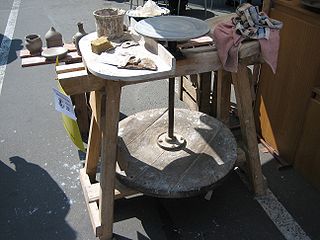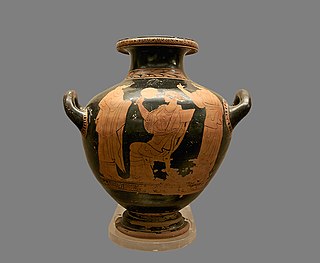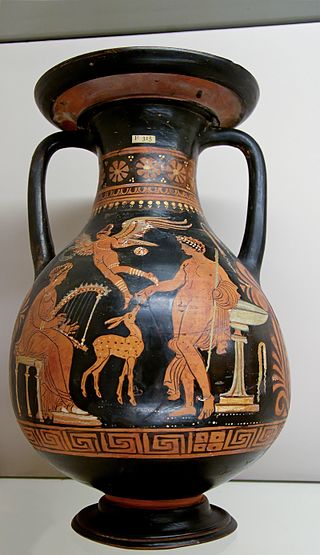
Pottery is the process and the products of forming vessels and other objects with clay and other raw materials, which are fired at high temperatures to give them a hard and durable form. The place where such wares are made by a potter is also called a pottery. The definition of pottery, used by the ASTM International, is "all fired ceramic wares that contain clay when formed, except technical, structural, and refractory products". End applications include tableware, decorative ware, sanitary ware, and in technology and industry such as electrical insulators and laboratory ware. In art history and archaeology, especially of ancient and prehistoric periods, pottery often means vessels only, and sculpted figurines of the same material are called terracottas.

An amphora is a type of container with a pointed bottom and characteristic shape and size which fit tightly against each other in storage rooms and packages, tied together with rope and delivered by land or sea. The size and shape have been determined from at least as early as the Neolithic Period. Amphorae were used in vast numbers for the transport and storage of various products, both liquid and dry, but mostly for wine. They are most often ceramic, but examples in metals and other materials have been found. Versions of the amphorae were one of many shapes used in Ancient Greek vase painting.

A vase is an open container. It can be made from a number of materials, such as ceramics, glass, non-rusting metals, such as aluminium, brass, bronze, or stainless steel. Even wood has been used to make vases, either by using tree species that naturally resist rot, such as teak, or by applying a protective coating to conventional wood or plastic. Vases are often decorated, and they are often used to hold cut flowers. Vases come in different sizes to support whatever flower is being held or kept in place.

In pottery, a potter's wheel is a machine used in the shaping of clay into round ceramic ware. The wheel may also be used during the process of trimming excess clay from leather-hard dried ware that is stiff but malleable, and for applying incised decoration or rings of colour. Use of the potter's wheel became widespread throughout the Old World but was unknown in the Pre-Columbian New World, where pottery was handmade by methods that included coiling and beating.

Black-figure pottery painting, also known as the black-figure style or black-figure ceramic, is one of the styles of painting on antique Greek vases. It was especially common between the 7th and 5th centuries BCE, although there are specimens dating in the 2nd century BCE. Stylistically it can be distinguished from the preceding orientalizing period and the subsequent red-figure pottery style.

Ceramics of Indigenous peoples of the Americas is an art form with at least a 7500-year history in the Americas. Pottery is fired ceramics with clay as a component. Ceramics are used for utilitarian cooking vessels, serving and storage vessels, pipes, funerary urns, censers, musical instruments, ceremonial items, masks, toys, sculptures, and a myriad of other art forms.

The hydria is a form of Greek pottery from between the late Geometric period and the Hellenistic period. The etymology of the word hydria was first noted when it was stamped on a hydria itself, its direct translation meaning 'jug'.

A lekythos is a type of ancient Greek vessel used for storing oil, especially olive oil. It has a narrow body and one handle attached to the neck of the vessel, and is thus a narrow type of jug, with no pouring lip; the oinochoe is more like a modern jug. In the "shoulder" and "cylindrical" types which became the most common, especially the latter, the sides of the body are usually vertical by the shoulder, and there is then a sharp change of direction as the neck curves in; the base and lip are normally prominent and flared. However, there are a number of varieties, and the word seems to have been used even more widely in ancient times than by modern archeologists. They are normally in pottery, but there are also carved stone examples.
The Iapygians or Apulians were an Indo-European-speaking people, dwelling in an eponymous region of the southeastern Italian Peninsula named Iapygia between the beginning of the first millennium BC and the first century BC. They were divided into three tribal groups: the Daunians, Peucetians and Messapians.
Geometric art is a phase of Greek art, characterized largely by geometric motifs in vase painting, that flourished towards the end of the Greek Dark Ages and a little later, c. 900–700 BC. Its center was in Athens, and from there the style spread among the trading cities of the Aegean. Though a not currently accepted concept by all scholars, the Greek Dark Ages were considered to last from c. 1100 to 800 BC and include the phases from the Protogeometric period to the Middle Geometric I period, which Knodell (2021) calls Prehistoric Iron Age. The vases had various uses or purposes within Greek society, including, but not limited to, funerary vases and symposium vases.

Bucchero is a class of ceramics produced in central Italy by the region's pre-Roman Etruscan population. This Italian word is derived from the Latin poculum, a drinking-vessel, perhaps through the Spanish búcaro, or the Portuguese púcaro.

Pottery and ceramics have been produced in the Levant since prehistoric times.

Apulian vase painting was a regional style of South Italian vase painting from ancient Apulia in southeast Italy. It comprises geometric pottery and red-figure pottery.

The Daunians were an Iapygian tribe that inhabited northern Apulia in classical antiquity. Two other Iapygian tribes, the Peucetians and the Messapians, inhabited central and southern Apulia respectively. All three tribes spoke the Messapic language, but had developed separate archaeological cultures by the seventh century BC.

Pottery was produced in enormous quantities in ancient Rome, mostly for utilitarian purposes. It is found all over the former Roman Empire and beyond. Monte Testaccio is a huge waste mound in Rome made almost entirely of broken amphorae used for transporting and storing liquids and other products – in this case probably mostly Spanish olive oil, which was landed nearby, and was the main fuel for lighting, as well as its use in the kitchen and washing in the baths.

Peucetian pottery was a type of pottery made in the Apulian region of southern Italy by the Peucetians from the beginning of the 7th to the 6th centuries BC. It is an indigenous type. Its production area occupied the space between Bari and Gnathia. The pottery was painted only in brown and black and was characterized by geometrical ornaments, swastikas, diamonds, and horizontal and vertical lines. These samples were mainly in the Late Geometric phase of ceramics with a close ornamental pattern. The second phase of the pottery since the 6th century BC is influenced strongly by the Corinthian vase painting. This is reflected both in the ornaments, decorations in the form of radiation, as well as a change to figurative representation. The third and final phase brings a shift in production methods. The pottery was hand-formed before the arrival of the Greeks in the southernmost tip of Italy, when the potter's wheel was introduced. The painting became purely ornamental. Shown on them are decorative plants like ivy and laurel vines and palmettes. Rare images included figurative and mythological figures.

Messapian pottery is a type of Messapian ceramic, produced between the 7th century BC until the 3rd century BC on the Italian region of southern Apulia. Messapian pottery was made by the Messapii, an ancient people inhabiting the heel of Italy since around 1000 BC, who migrated from Crete and Illyria. Messapian pottery consisted first primarily, with geometric patterns like circles, squares, diamonds, horizontal dash patterns, swastika and other similar motifs. Late through Greek influence the meander was added. From about the beginning of the 5th century BC again under Greek influence, with imports of Attic pottery, figurative decoration was added. In addition, leaf motifs, new elements such as ivy and other repertoire were included. Up to then only fragments of the pottery was decorated in contrast to the whole surface being decorated after the 5th century BC. In the fourth century BC, the artists came back again to geometric ornamentation, but by then the ceramics were almost completely under Greek influence.

Ceramic art is art made from ceramic materials, including clay. It may take varied forms, including artistic pottery, including tableware, tiles, figurines and other sculpture. As one of the plastic arts, ceramic art is a visual art. While some ceramics are considered fine art, such as pottery or sculpture, most are considered to be decorative, industrial or applied art objects. Ceramic art can be created by one person or by a group, in a pottery or a ceramic factory with a group designing and manufacturing the artware.
The conservation and restoration of ancient Greek pottery is a sub-section of the broader topic of conservation and restoration of ceramic objects. Ancient Greek pottery is one of the most commonly found types of artifacts from the ancient Greek world. The information learned from vase paintings forms the foundation of modern knowledge of ancient Greek art and culture. Most ancient Greek pottery is terracotta, a type of earthenware ceramic, dating from the 11th century BCE through the 1st century CE. The objects are usually excavated from archaeological sites in broken pieces, or shards, and then reassembled. Some have been discovered intact in tombs. Professional conservator-restorers, often in collaboration with curators and conservation scientists, undertake the conservation-restoration of ancient Greek pottery.

The Culture of ancient Illyria or Illyrian culture begins to be distinguished by increasingly clear features during the Middle Bronze Age and especially at the end of the Late Bronze Age. Ceramics as a typical element is characterized by the extensive use of shapes with two handles protruding from the edge as well as decoration with geometric motifs. At this time the first fortified settlements were established. The local metallurgy produced various types of weapons on the basis of Aegean prototypes with an elaboration of artistic forms. The main tools were the axes of the local types "Dalmato-Albanian" and "Shkodran", as well as the southern type of double ax. Spiritual culture is also expressed by a burial rite with mounds (tumuli) in which a rich material of archaeological artifacts has been found.

















